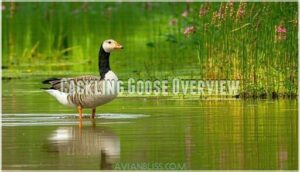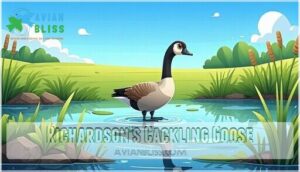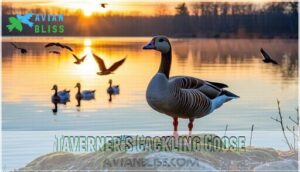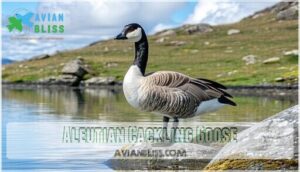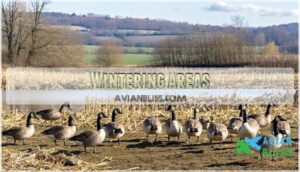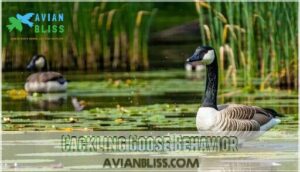This site is supported by our readers. We may earn a commission, at no cost to you, if you purchase through links.
 You’ll find cackling geese masquerading as their bigger Canada goose cousins until you spot the telltale signs.
You’ll find cackling geese masquerading as their bigger Canada goose cousins until you spot the telltale signs.
These compact waterfowl sport stubby necks, rounded heads, and proportionally smaller bills that give them away. At 1.5-3 pounds, they’re substantially lighter than Canada geese’s 6-14 pounds.
Four distinct subspecies exist, from Alaska’s minima to the Aleutian populations. Their high-pitched calls sound more like excited chatter than the honking you’d expect.
Cackling geese breed across Alaska and northern Canada, wintering throughout western North America. Watch for their rapid wingbeats and tight flocking behavior – dead giveaways when mixed flocks leave you scratching your head about proper identification.
Table Of Contents
- Key Takeaways
- Cackling Goose Overview
- Cackling Goose Subspecies
- Cackling Goose Habitat
- Cackling Goose Behavior
- Cackling Goose Conservation
- Frequently Asked Questions (FAQs)
- Is cackling goose the same as Canada goose?
- Where are Cackling Geese found?
- Are cackling goose rare?
- What is another name for a cackling goose?
- How can you tell a Cackling Goose from a Canada goose?
- Where do Cackling Geese live?
- What is another name for a Cackling Goose?
- Why is the Cackling Goose endangered?
- What does a cockling geese look like?
- What is a cackling goose?
- Conclusion
Key Takeaways
- You’ll distinguish cackling geese from Canada geese by their compact size – they’re substantially lighter, at 1.5-3 pounds, versus 6-14 pounds, with stubby necks, rounded heads, and proportionally smaller bills.
- Listen for their high-pitched chattering calls instead of deep honking – their excited, chatter-like vocalizations are a dead giveaway when you can’t clearly see size differences in mixed flocks.
- Watch for their rapid wingbeats and tight flocking behavior during migration – these movement patterns help you identify them even at a distance when size comparison becomes difficult.
- You’ll find four distinct subspecies across their range – from Alaska’s tiny, dark minima to the larger hutchinsii, each with unique characteristics that can aid in field identification.
Cackling Goose Overview
You’ll quickly discover that distinguishing Cackling Geese from Canada Geese ranks among North America’s most challenging waterfowl identifications.
These compact geese will test your identification skills like no other waterfowl challenge.
These compact geese were considered the same species as Canada Geese until 2004, when taxonomists recognized their distinct smaller size, higher-pitched vocalizations, and genetic differences, which led to them being classified as a separate species due to their genetic uniqueness.
Physical Characteristics
You’ll quickly recognize Cackling Geese by their distinctively compact build and smaller stature compared to their Canada Goose cousins.
These stocky birds break free from the typical "big goose" mold with their proportionally shorter necks and stubby bills.
Key physical features include:
- Body Size: Weighs 49-84 oz with a 42-43 inch wingspan – similar to a mallard
- Head Structure: Rounded, boxy head with steep bill-to-forehead angle creating triangular profile
- Plumage Color: Grayish-brown body with light tan feather tips, black neck, white chinstrap, and occasional white collar
Cackling Geese are known to be migratory game birds with specific conservation needs.
Size Comparison
You’ll notice dramatic weight differences between these species—Canada Geese tip the scales at nearly twice a Cackling Goose’s weight.
Size variance becomes your best friend for identification, though smaller Canada Geese females can muddy the waters.
Body proportions tell the real story: Cackling Geese sport stubbiest necks, shorter bills, and more compact frames that’ll make size comparison feel like comparing a football to a baseball.
Understanding the physical characteristics of a goose vs duck is essential for accurate identification and appreciation of their unique traits.
Plumage
You’ll spot these feathered friends by their distinctive plumage patterns.
Cackling Geese share Canada Geese’s classic black head and neck with white cheek patches, but their body feather color varies dramatically between subspecies.
The darkest minima subspecies sports rich chocolate-brown body plumage, while hutchinsii displays pale gray-brown tones.
Wing patterns remain consistent across subspecies, though tail feathers may show subtle variations in darkness.
Bill and Head Shape
Examining a Cackling Goose’s head reveals key identification markers that separate it from its larger cousin.
A stubby bill and rounded head create the Cackling Goose’s distinctive compact facial profile.
You’ll notice the bill appears stubbier and shorter, creating a more compact facial profile.
The head shape tends toward rounded rather than elongated, with skull anatomy reflecting the bird’s smaller overall size.
This beak structure difference becomes especially apparent when comparing bill length ratios to head size across both species, highlighting the importance of key identification markers.
Neck Length
Beyond bill structure, you’ll notice Cackling Geese sport noticeably shorter necks than their Canada Goose cousins.
This neck length difference becomes your ace in the hole for field identification, especially when size variation creates confusion among mixed flocks.
- Neck Structure: Cackling Geese display proportionally shorter, thicker necks that appear more compact against their body size
- Length Variation: Canada Geese stretch their necks to nearly twice the relative length, creating an elongated silhouette
- Beak Alignment: The shorter neck positioning affects head carriage, with Cackling Geese showing less pronounced neck extension during alert postures
Cackling Goose Subspecies
You’ll encounter four distinct subspecies of Cackling Goose, each with unique characteristics that can help you distinguish them in the field.
These subspecies range from the tiny, dark minima to the larger, paler hutchinsii, creating identification challenges that even experienced birders find tricky.
Richardson’s Cackling Goose
Richardson’s Cackling Goose subspecies (Branta hutchinsii hutchinsii) represents the most widespread of the four cackling goose subspecies. You’ll recognize this Arctic breeding bird by its distinctively compact build and pale feather coloration compared to other subspecies.
This goose subspecies migrates from central Canadian breeding grounds to southern Great Plains wintering areas, where bird identification becomes crucial for proper avian taxonomy classification. Understanding the geese identification techniques is essential for distinguishing between different species.
| Feature | Richardson’s Cackling Goose | Comparison Notes |
|---|---|---|
| Weight | 49.3-84 oz (1,400-2,380g) | Intermediate size among subspecies |
| Length | 24.8-25.6 inches | Markedly smaller than Canada Goose |
| Bill Shape | Short, stubby (1.8:1 ratio) | Less than half head length |
| Neck | Distinctly short, black | Key identification feature |
| Coloration | Pale grayish-brown body | Lightest of cackling subspecies |
Richardson’s lacks the white collar typical of Aleutian subspecies, displaying uninterrupted black necking. Their goose vocalization produces higher-pitched calls than Canada Geese, helping distinguish during geese migration periods when flocks intermingle.
Taverner’s Cackling Goose
Taverner’s Cackling Goose (Branta hutchinsii taverneri) represents the largest subspecies among Cackling geese, creating identification challenges that’ll test your birding skills.
This heavyweight champion breeds from northeastern Alaska into Canada before heading to southwestern wintering grounds.
- Size advantage – Largest Cackling goose subspecies, sometimes rivaling smaller Canada Geese
- Beak shape – Slightly longer bill compared to other Cackling subspecies
- Feather color – Moderate plumage tones between dark and pale extremes
- Flock dynamics – Often mixed with Canada Geese during Geese Migration periods
- Habitat loss threatens breeding grounds across their northern range
Minima Cackling Goose
The minima subspecies represents the smallest and darkest Cackling goose.
You’ll find these compact birds in western Alaska’s arctic breeding grounds during summer months. Their dark plumage lacks the distinct white collar seen in other subspecies, making identification straightforward once you know what to look for.
| Feature | Minima Characteristics | Comparison Notes |
|---|---|---|
| Size | Smallest subspecies | Often compared to Lesser Canada Goose |
| Coloration | Darkest plumage | No white collar present |
| Breeding Range | Western Alaska | Arctic tundra habitat |
| Wintering Areas | Oregon and California | Pacific Coast migration route |
The key characteristics of the minima subspecies, including its dark plumage and smallest size, distinguish it from other subspecies. The arctic breeding grounds in western Alaska and wintering areas in Oregon and California are also notable features of this subspecies.
Aleutian Cackling Goose
You’ll spot the Aleutian cackling goose by its distinctive white collar marking where the black neck meets brown body.
This subspecies breeds on Alaska’s Aleutian Islands and winters in central California. They’re paler than the minima subspecies and represent the second smallest of all cackling goose subspecies, making island ecology adaptations essential for their arctic breeding success during goose migration.
The evolution of certain bird species with long tail feathers highlights the importance of unique physical characteristics in enhancing survival and mating prospects.
Cackling Goose Habitat
Understanding cackling goose habitat requirements helps you predict where you’ll encounter these compact waterfowl throughout their annual cycle.
These arctic breeders follow predictable migration patterns between their tundra nesting grounds and southern wintering areas.
Breeding Grounds
Cackling Geese breed across the Arctic regions, from western Alaska to eastern Canada’s tundra.
You’ll find their nesting sites on barren uplands, tundra islands, and riverbanks where harsh conditions shape their breeding habits.
Unlike Canada Goose populations that nest farther south, Cackling goose subspecies depend entirely on these remote Arctic breeding grounds for successful reproduction, making habitat preservation critical for their survival.
Understanding these birds’ reliance on specific habitats, such as unique bird habitats, is essential for conservation efforts and their survival.
Wintering Areas
When breeding season ends, you’ll find these geese escaping winter’s harsh grip by heading to warmer territories.
Pacific Coast states like California and Oregon host massive flocks, while Southern Plains regions welcome central Arctic populations.
Farm fields become dining rooms where Cackling geese feast alongside Canada geese.
Lake habitats provide roosting spots during their wintering period.
Bird migration brings them to marshes and agricultural areas from November through March, creating spectacular viewing opportunities for dedicated birders tracking these migratory birds throughout their seasonal goose habitat preferences.
Migration Routes
Following established flyway patterns, these migratory birds navigate three major flight corridors across North America.
Pacific Flyway populations travel from Alaska to California’s Central Valley, while Central Flyway birds winter in Texas and Oklahoma.
Migration timing spans September through November, with critical stopover sites in the Prairie Pothole Region and Klamath Basin providing essential refueling opportunities during their epic journeys to wintering grounds.
Cackling Goose Behavior
Understanding Cackling Goose behavior helps you distinguish them from Canada Geese in mixed flocks during migration and winter months.
You’ll observe distinct patterns in their flocking, foraging, nesting, and hybridization behaviors that complement the physical identification features covered earlier.
Flocking
You’ll often see these geese mingling with Canada Geese during winter months, creating mixed flocks that challenge identification skills.
Their social structure mirrors that of their larger cousins, with family groups staying together throughout migration patterns.
Watch how cackling geese maintain tight flight formations during travel, demonstrating remarkable group behavior coordination.
These flocking dynamics help protect smaller individuals from predators while maximizing feeding efficiency in agricultural areas.
The study of flocking behavior is related to goose model systems.
Foraging
Unlike their more sedentary cousins, you’ll find Cackling Geese constantly on the move while foraging, grazing on grasses and aquatic plants with remarkable efficiency.
Their feeding habits mirror those of other waterfowl but with notable intensity – these birds don’t mess around in their pursuit of meeting their dietary needs.
Their grazing patterns shift seasonally, targeting nutrient-rich food sources.
The geese also rely on ideal waterfowl feed management to sustain themselves throughout the year, utilizing efficient foraging strategies.
Hybridization
Hybridization between cackling and Canada geese occurs naturally where their ranges overlap, creating fascinating genetic mixing opportunities.
Cross breeding happens in approximately 5-10% of geese in overlap zones, producing hybrid birds with intermediate characteristics.
Key hybridization factors include:
- Geographic overlap – Species blending occurs primarily between 59°N-60°N latitude along western Hudson Bay
- Mate availability – Gene flow increases when conspecific partners are scarce at range margins
- Fertile offspring – Most hybrids remain viable, enabling continued avian genetics exchange through backcrossing
This genetic variation complicates field identification since hybrid birds display mixed morphological traits that don’t fit typical species differentiation patterns.
Nesting Habits
Cackling Geese construct their nests on arctic tundra, selecting elevated sites near water for protection from predators.
You’ll find their nest sites on islands, riverbanks, and barren uplands across Alaska and northern Canada.
| Nesting Aspect | Details |
|---|---|
| Nest Site | Tundra islands, riverbanks, elevated areas |
| Clutch Size | 4-6 white eggs per season |
| Incubation | Female incubates for 24-26 days |
| Brood Care | Both parents protect goslings until fledging |
The female handles incubation duties while the male serves as a vigilant nest protector, standing guard against arctic foxes and other threats.
Their bird habitat preferences guarantee goslings have immediate access to feeding areas once they hatch, making these locations critical for successful reproduction.
Cackling Goose Conservation
You’ll find that Cackling Geese maintain stable populations across their range, earning a "Least Concern" status on the IUCN Red List.
These hardy birds benefit from strong legal protections under the Migratory Bird Treaty Act, though they still face challenges from habitat loss and climate change impacts on their Arctic breeding grounds.
IUCN Red List
You’ll find the Cackling Goose enjoys solid conservation status on the IUCN Red List.
Global Protection assessments show this species thriving across North America, proving that effective bird conservation works when done right.
The conservation efforts are supported by bird species preservation strategies that help maintain stable populations.
- Red List Status: Currently listed as Least Concern with stable populations
- Conservation Ranking: Partners in Flight assigns low concern score of 8/20
- Species Assessment: Global population estimated at 3 million individuals in 2021
Threats
Several major threats challenge Cackling Goose populations across their range.
Habitat loss from development and agriculture reduces breeding sites, while climate change alters migration timing and Arctic nesting conditions.
Human disturbance at roosting areas creates stress, and hunting pressure requires careful management to prevent population declines.
| Threat Category | Primary Impact | Affected Life Stage |
|---|---|---|
| Habitat Loss | Reduced breeding success | Nesting adults |
| Climate Change | Altered migration patterns | All ages |
| Human Conflict | Increased mortality | Wintering flocks |
Pollution effects from agricultural runoff contaminate feeding areas, while predators like foxes and ravens threaten nest survival.
Human disturbance during critical periods can lead to nest abandonment, reducing reproductive success and threatening long-term survival of vulnerable subspecies.
Conservation Efforts
How do scientists guarantee these small geese survive in our changing world?
Wildlife conservation efforts focus on thorough habitat preservation and species protection through targeted conservation strategies.
Key conservation efforts include:
- Habitat Preservation – Over 60,000 acres of breeding and wintering habitat restored in California and Alaska since 1990
- Wildlife Management – Controlled burns and grazing management improve grassland quality for migrating populations
- Species Protection – Fox removal from Aleutian breeding islands increases nest success rates substantially
These avian conservation efforts maintain ecological balance through adaptive management plans that adjust hunting quotas based on real-time population data, guaranteeing long-term bird conservation success.
Effective conservation plans, such as those involving Goose Conservation, are vital for the protection of these species.
Protected Status
Federal Migratory Laws provide robust Species Protection for Cackling Goose populations under the Migratory Bird Treaty Act.
The USFWS manages their conservation status through hunting quotas and habitat preservation.
While not on the Endangered List, these geese benefit from Wildlife Refuge systems and Conservation Acts that safeguard arctic breeding grounds, ensuring stable populations across their range.
Frequently Asked Questions (FAQs)
Is cackling goose the same as Canada goose?
Strange twist of fate – these two looked identical until 2004, when scientists split them into separate species.
They’re distinct species but nearly identical in plumage, with Cacklings being much smaller and producing higher-pitched calls than their deep-honking cousins, which is a notable difference in their plumage.
Where are Cackling Geese found?
You’ll find these smaller geese breeding across Alaska and northern Canada’s arctic regions, then migrating to winter in California, the Pacific Northwest, and southern Great Plains states.
Are cackling goose rare?
No, they’re not particularly rare. You’ll find them migrating through most of North America, though they’re less common than Canada Geese and can be tricky to spot mixed in flocks.
What is another name for a cackling goose?
Richardson’s Goose represents another name you’ll encounter for the hutchinsii subspecies of cackling goose.
This taxonomic title honors Arctic explorer Sir John Richardson, reflecting the bird’s northern breeding grounds and distinct characteristics.
How can you tell a Cackling Goose from a Canada goose?
You’ll spot key differences through size, voice, and proportions. Cackling Geese are noticeably smaller with shorter necks, stubby bills, and produce high-pitched cackles versus Canada Geese’s deep honks.
Where do Cackling Geese live?
Coincidentally, you’ll encounter these arctic wanderers across vast territories.
Cackling Geese breed in northern Alaska and Canada’s tundra, then migrate to winter in California, Pacific Northwest, and southern Great Plains through March, which involves vast territories and a notable migration pattern to winter.
What is another name for a Cackling Goose?
You’ll often hear Richardson’s Goose used interchangeably with the hutchinsii subspecies.
This technical name honors Arctic explorer Sir John Richardson, who first described this distinctive waterfowl during his northern expeditions in the 1800s, and is a distinctive waterfowl with a name that also honors Arctic explorer Sir John Richardson.
Why is the Cackling Goose endangered?
The Cackling Goose isn’t endangered – you’re thinking of a different bird! It’s actually classified as "Least Concern" with stable populations protected under migratory bird laws.
What does a cockling geese look like?
You’ll recognize these compact geese by their short necks, stubby bills, and high-pitched cackling calls.
They’re noticeably smaller than Canada Geese, with similar black-and-white head patterns but more petite proportions overall.
What is a cackling goose?
Like Shakespeare’s "tempest in a teapot," you’ll find this smaller goose packs big personality.
A cackling goose is a compact waterfowl species, smaller than Canada geese, with distinctive high-pitched calls and four recognized subspecies throughout North America.
Conclusion
Paradoxically, separating the cackling goose from its Canada goose relatives requires you to focus on what’s missing rather than what’s there.
You’ll master identification by recognizing their compact proportions, stubby necks, and proportionally smaller bills.
Listen for their distinctive high-pitched calls that contrast sharply with Canada geese honking.
Watch their rapid wingbeats and tight flocking behavior during migration.
With practice, distinguishing these smaller waterfowl becomes second nature, transforming confusion into confident field identification skills.

